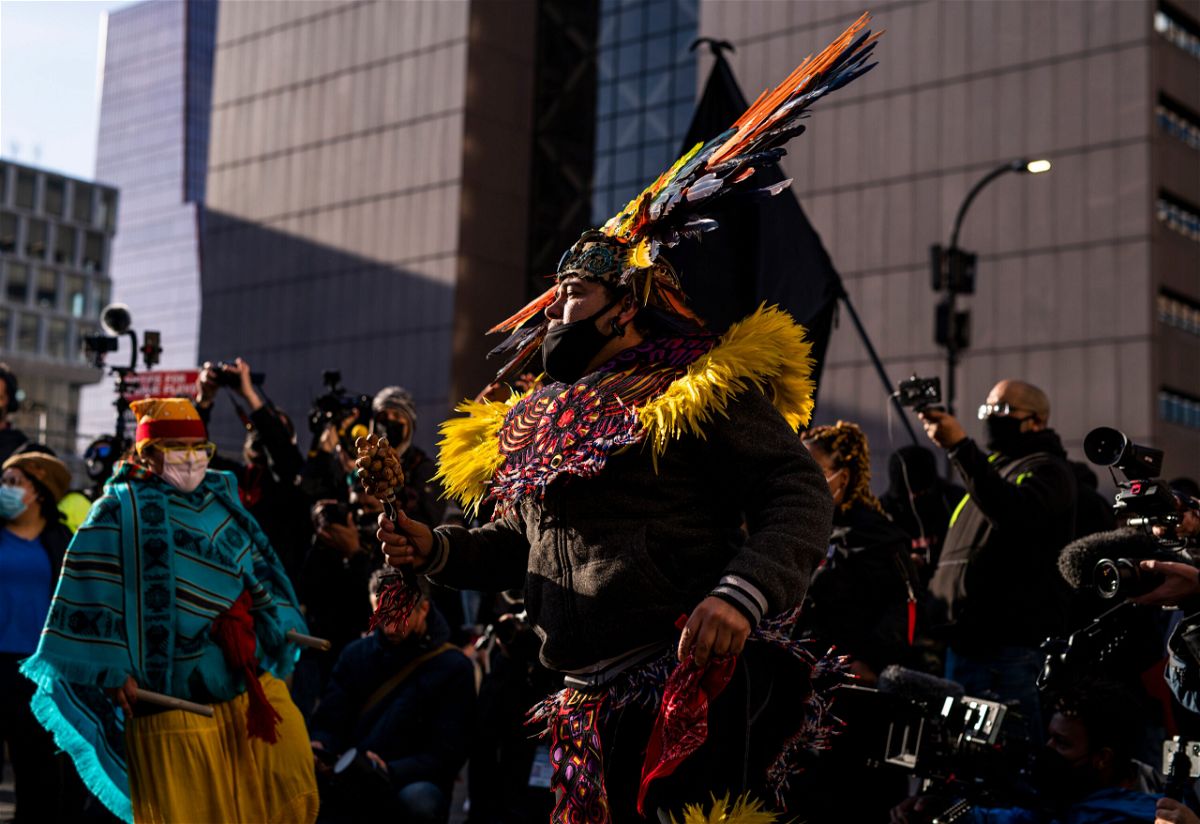Land acknowledgments are often an empty gesture, some Indigenous people say

Kalpulli Yaocenoxtli
By Harmeet Kaur, CNN
From universities to sports games to city council meetings to Twitter bios, it’s becoming increasingly common to see statements recognizing that the land on which one is standing once belonged to Indigenous people.
These statements, known as land acknowledgments, are an attempt to address the past, present and future of a particular location as it relates to Indigenous peoples as well as to understand one’s own place within it. A land acknowledgment might be spoken before a public gathering or issued as a written statement by an institution.
It could be as simple as saying, “This event is taking place on the traditional lands of the Muscogee (Creek) Nation.” It could take a more specific approach, such as “We recognize the sustained oppression, land dispossession, and involuntary removals of the Muscogee and Cherokee peoples from Georgia and the Southeast …” On social media, it might show up as a red pushpin emoji, followed by the name of the tribe whose homelands one is on.
While Indigenous peoples have practiced land acknowledgments for generations, Westerners have adopted the custom relatively recently as they attempt to reckon with the harms brought on by colonization. Land acknowledgments are now routine in Australia, Canada and New Zealand, and are becoming increasingly prevalent in progressive spaces in the US.
But while land acknowledgments are usually well-intentioned, some Indigenous scholars and leaders say that the ways they are sometimes executed by non-Natives can seem hollow, performative and ultimately, problematic.
“It feels like a box checking activity, like people are doing it to signal their politics,” says Len Necefer, an Indigenous studies scholar and founder and CEO of the apparel and media company NativesOutdoors. “That’s often how it can come off.”
Here’s why some take issue with land acknowledgments and what they say needs to happen for real repair and reconciliation to occur.
They can obscure the actual history
Land acknowledgments are generally meant to acknowledge the Indigenous history of the land one is on. But for Michael Lambert, many such statements don’t adequately reflect how Indigenous peoples were forcibly removed from their lands.
Lambert, associate professor of African Studies and Anthropology at the University of North Carolina at Chapel Hill, says such statements often refer to Indigenous peoples as the original “stewards” or “custodians” of land that is now occupied by another entity. To him, that language obscures the fact that tribal nations were sovereign over those lands and that they weren’t just caretakers.
“It’s like, ‘Oh gee, thanks for taking care of the land so well. We promise to do a better job in the future,'” says Lambert, who is an enrolled citizen of the Eastern Band of Cherokee Indians. “It comes across as a very painful denial of exactly what happened.”
Some land acknowledgments also fail to acknowledge the traumas that accompanied Native people being removed from their lands, Lambert adds.
“That process of transferring control from the Indians to the non-Indians was fraught with conflict, it was violent, it involved murder in some cases and extreme pain,” he says.
Another issue Lambert sees in some land acknowledgments is that they can suggest Indigenous peoples — and by extension, issues of land dispossession — are a relic of the past, when Native communities are living many of these realities today.
“Land dispossession is continuing,” he adds. “It hasn’t ended.”
They can oversimplify the issues at hand
Necefer, a member of the Navajo Nation, recalls a recent experience he had while on a conference call, during which each participant was asked to recognize the Indigenous people whose homelands they were calling from.
The exercise felt uncomfortable and awkward, Necefer wrote in Outside magazine. He was calling from his mother’s house in Albuquerque, New Mexico, which Navajos have considered their homelands for centuries. But it struck him that many Pueblos in the area would dispute those claims — and a brief land acknowledgment would oversimplify what was actually a complex and contested history.
He notices a similar lack of nuance in the ways people determine whose land they’re on. Native Lands Digital, a commonly used app run by a Canadian nonprofit, allows users to input an address to see what tribal nations lived there. But the map only includes the names of those tribes, without the history or context around potentially contested claims to the land. Some of the tribes listed are “functionally extinct,” he says, and are grouped in with nations that continue to exist in the area. (Native Lands Digital, which did not immediately respond to questions from CNN, says in a disclaimer on the site that the map is “not perfect” and is a work in progress.) Many people who use the app tend to approach it as the endpoint rather than the starting point, he adds.
“I could see that people are just copying and pasting this stuff without really looking into the details,” Necefer tells CNN.
In other cases, land acknowledgments might refer to “stolen land” — a seemingly well-intentioned phrase designed to convey how Native people were driven from their homes. But while some tribes might agree with that characterization, Necefer says, others view the situation differently: Rather than land belonging to people, people belong to the land.
“Landscapes’s elements make up the blood, bone, and flesh that animate our bodies. When we die, we return to the land and turn into the trees, rocks, and water that once gave us life,” he wrote in Outside. “The phrase ‘on stolen land’ can unknowingly erase these cultural views.”
They can overburden Native people
Native Governance Center, a nonprofit organization that seeks to help tribal nations strengthen their governance systems and their capacity to exercise sovereignty, began developing resources on how to put together a land acknowledgment a few years ago as it noticed more people in the US talking about the issue.
As a result, the organization started getting hundreds of inquiries from people who were interested in doing land acknowledgments of their own, says Apryl Deel-McKenzie, program manager for Native Governance Center. The group initially saw this as an encouraging sign, but they soon found that some non-Native people expected them to do the work for them for free.
“We had a lot of inquiries from non-Native people saying, ‘Hey, we’re wanting to do a land acknowledgement: Can you read this? Can you do this? Can you help us research?'” she says. “It’s important people understand that when you put that upon Indigenous people, it can create a lot of additional stress on Native peoples and Native organizations.”
Larry Chavis, former director of UNC’s American Indian Center, put it like this at a faculty council meeting after being asked to write a land acknowledgment for the university: “It’s like me writing my own thank you note for a gift that was taken from me.”
They can be seen as just enough
Another issue that Deel-McKenzie observed was that many people seemed too caught up in the particulars of the statement’s wording, without enough consideration on how they planned to support Indigenous communities moving forward.
“It’s not about the verbiage,” she says. “It’s not about your statement being ‘correct.’ It’s not about performance either. It’s about the action that needs to happen.”
Deel-McKenzie says a land acknowledgment should be seen as a first step — one that must be followed by a call to action. It’s a view shared by many Indigenous scholars and activists, though they might have different ideas on what constitutes sufficient action.
For Lambert, the most logical next step is to give the land back.
“If they’re going to acknowledge what happened in the transfer of this land from Indian to non-Indian control, there has to be some proactive action on the part of the institution for the aggrieved group,” he said. “I think that Indians would say, ‘We want the land back.'”
Native Governance Center counts land repatriation as one of several ways that institutions and individuals might go beyond a simple land acknowledgment. Another action it proposes is voluntary land taxes — regular payments that go directly toward Native nations or organizations in the area. It could involve showing up to demonstrations led by Indigenous people in the area. For universities, it might be offering free tuition for Indigenous students, and for corporations, it might be committing to hire Native people in leadership positions.
“The bottom line in terms of Indigenous land acknowledgments is that it’s one component that raises awareness about Indigenous peoples here in this country in the United States,” Deel-McKenzie says.
Necefer says his organization NativesOutdoors has moved away from the red pin emojis in social media captions that function as land acknowledgments and is instead focusing its efforts on more ambitious ways they can educate non-Native audiences about the history of the places they live. But despite the flaws in some land acknowledgments, he and others say they aren’t suggesting that the practice be done away with altogether.
Land acknowledgments can be a good way for people to learn more about Indigenous history and can signal respect for tribal nations. Rather, those critical of these statements emphasize that they should be seen as a starting point in a larger effort to understand the histories and realities of Indigenous people and to commit to change.
“It’s an imperfect tool,” Necefer says. “We have to understand what it is. If we can understand that, I think the rest will come.”
The-CNN-Wire
™ & © 2021 Cable News Network, Inc., a WarnerMedia Company. All rights reserved.


